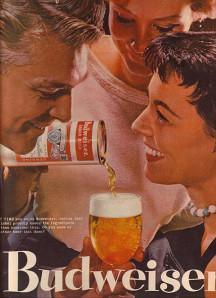Remember that? In 2003, this was the apex of advertising for Miller Lite, who aired the ad during that year’s Super Bowl. The cause of the argument – “great taste” or “less filling” – doesn’t really focus on the beer, does it?
But that’s the point.
Until the recent surge of craft, we haven’t truly lived in a world where beer itself could handle the focus of a consumer. When product choices consist of various American light lagers that offer the same drinking experience, it’s important to use some smoke and mirrors to make a sale.
In this case, it’s the idea that female sexuality is more adept at capturing an audience than the otherwise boring product itself. This not only devalues women, but the product trying to be sold. That is, if you can look past the scantily-clad game that’s being played in front of you.
Which leads to this question: what happens to the role of females in when the product does start selling itself in a culture built to the male ego?
 Going back to the mainstream ads of the 1960s, breweries like Budweiser were reliant on propping up the male ego. It was all about making the drinker (naturally, a man) feel powerful. They were about showing American males who were fit, professionally dressed, happy and being served:
Going back to the mainstream ads of the 1960s, breweries like Budweiser were reliant on propping up the male ego. It was all about making the drinker (naturally, a man) feel powerful. They were about showing American males who were fit, professionally dressed, happy and being served:
Servers are always pleased to serve in the Budweiser advertisements, and are often attractive women … not one of the women shown was wearing a wedding band.
But that was a long time ago. As we’ve moved away from needing women as objects to sell beer, why is it so hard to include them elsewhere? As the industry provides us more styles and flavors to choose from, women should be acknowledged as an important demographic to the success of the beer industry.
We’ve reached a point where it’s no longer viable to hide behind the veil of sexualized marketing, but I wonder if we’re able to shake that male-centric approach so built into the history of the industry and consumers. Not just in a marketing sense, but in our own expectations borne from that.
It used to be if we drank a certain product, women would be beautiful, buxom and plentiful. We’d be fit, happy and among friends.
We’ve always placed masculine value on the act of drinking, but there was a narrowly-focused role for women until the last 10 years or so. As we begin to realize women can have other roles in beer culture – as they should – is the act of accepting them as peers a problem?
One area that may be of disservice to us is the method of drinking as a man-making act. Based on cultural expectations, we would expect men to drink more, women to drink less. As a means to prove male dominance, drinking becomes a game to prove worth:
External physical threats are supplemented and can be replaced by symbolic tests of strength, skill, and self-control. And some of these tests revolve around drinking. The challenge is to hold your liquor, to be able to drink without showing any ill effects, at least relative to your peers. Drinking can serve as a symbolic re-enactment of overcoming a challenge because in itself it is a challenge.
In addition, we are taught from an early age to accept these kinds of roles as a narrative started in our youth:
…environmental factors counteract anxious tendencies among boys but support them among girls … there is a shift toward greater negative affectivity among girls during the developmental period at which gender socialization becomes evident. Thus, gender differences … are likely moderated by socialization processes that prescribe gender-specific expectations regarding the expression of anxiety and the acceptable means of coping with anxiety.
In the context of a male-dominated industry, women are starting from a place where they’ve been more or less conditioned to not rock the boat. Society may accept the foolishness of men, but sets expectations for women to be more timid or focus on a goal of perfection.

Girls Pint Out is a great addition to the beer community to encourage more female involvement.
Seeing women enjoy beer or working with beer or talking about beer shouldn’t have to be a novelty, it’s just that as men, I feel we’ve been taught that it should be. Even worse, we’ve created a situation where we don’t expect women to feel as comfortable as we do.
Men have always been told they are the focus of beer and the lifestyle beer offers. But as the narrative changes thanks to the rise of craft beer and the community it creates, we as men have a responsibility to change our expectations. Even if we suffer from a collective hangover built on decades of messaging.
Which brings us back to the problem at hand: if women aren’t objects in the context of beer, why can’t we just let them be a part of the club?
It’s with that question that I’ll bring in voices of women in the next post to further discuss the topic.
Note: This is the 14th version I’ve written of this post, which perhaps lends itself to emphasize the depth and difficulty of this subject. I by no means expect my thoughts to be an end-all, but rather just a small part of the discussion. Certainly different people have different experiences, which is why I’m trying to approach this topic broadly. Another related series of posts that may be of interest come from a past Session topic on women and beer.
+Bryan Roth
“Don’t drink to get drunk. Drink to enjoy life.” — Jack Kerouac

